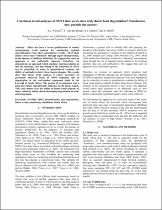 ResearchSpace
ResearchSpace
Can linear trend analyses of NDVI time series data truly detect land degradation? Simulations may provide the answer
JavaScript is disabled for your browser. Some features of this site may not work without it.
- ResearchSpace
- →
- Research Publications/Outputs
- →
- Conference Publications
- →
- View Item
| dc.contributor.author |
Wessels, Konrad J

|
|
| dc.contributor.author |
Van den Bergh, F

|
|
| dc.contributor.author |
Scholes, RJ

|
|
| dc.contributor.author |
Miteffa, S

|
|
| dc.date.accessioned | 2011-09-23T09:18:04Z | |
| dc.date.available | 2011-09-23T09:18:04Z | |
| dc.date.issued | 2011-04 | |
| dc.identifier.citation | Wessels, KJ, Van den Bergh, F, Scholes, RJ. 2011. Can linear trend analyses of NDVI time series data truly detect land degradation? Simulations may provide the answer. 34th International Symposium for Remote Sensing of Environment. Sydney Convention & Exhibition Centre Sydney, Australia, 10-15 April 2011 | en_US |
| dc.identifier.uri | http://hdl.handle.net/10204/5170 | |
| dc.description | 34th International Symposium for Remote Sensing of Environment. Sydney Convention & Exhibition Centre Sydney, Australia, 10-15 April 2011 | en_US |
| dc.description.abstract | There has been a recent proliferation of remote sensing-based trend analysis for monitoring regional desertification. These show contradictory results. All of them claim to have been “validated” through expert interpretation, in the absence of sufficient field data. The authors suggest that such an approach is not sufficiently rigorous. Therefore, they demonstrate an approach which simulates land degradation so that the intensity, rate and timing of the reduction in NDVI can be controlled, in order to quantitatively evaluate the ability of methods to detect these known changes. The results show that linear trend analysis is rather insensitive to previously observed levels of NDVI reduction due to degradation in the well-studied communal lands in the Lowveld of South Africa. The period of investigation, has a large but rather unpredictable influence on the linear trends. This casts doubts over the ability of linear trend analysis, to detect relatively subtle, slowly-developing degradation in semiarid rangelands. | en_US |
| dc.language.iso | en | en_US |
| dc.relation.ispartofseries | Workflow request;7223 | |
| dc.subject | Remote sensing | en_US |
| dc.subject | Regional desertificatio | en_US |
| dc.subject | AVHRR | en_US |
| dc.subject | NDVI | en_US |
| dc.subject | Desertification | en_US |
| dc.subject | Land degradation | en_US |
| dc.subject | Linear trends | en_US |
| dc.subject | South African Lowveld | en_US |
| dc.title | Can linear trend analyses of NDVI time series data truly detect land degradation? Simulations may provide the answer | en_US |
| dc.type | Conference Presentation | en_US |
| dc.identifier.apacitation | Wessels, K. J., Van den Bergh, F., Scholes, R., & Miteffa, S. (2011). Can linear trend analyses of NDVI time series data truly detect land degradation? Simulations may provide the answer. http://hdl.handle.net/10204/5170 | en_ZA |
| dc.identifier.chicagocitation | Wessels, Konrad J, F Van den Bergh, RJ Scholes, and S Miteffa. "Can linear trend analyses of NDVI time series data truly detect land degradation? Simulations may provide the answer." (2011): http://hdl.handle.net/10204/5170 | en_ZA |
| dc.identifier.vancouvercitation | Wessels KJ, Van den Bergh F, Scholes R, Miteffa S, Can linear trend analyses of NDVI time series data truly detect land degradation? Simulations may provide the answer; 2011. http://hdl.handle.net/10204/5170 . | en_ZA |
| dc.identifier.ris | TY - Conference Presentation AU - Wessels, Konrad J AU - Van den Bergh, F AU - Scholes, RJ AU - Miteffa, S AB - There has been a recent proliferation of remote sensing-based trend analysis for monitoring regional desertification. These show contradictory results. All of them claim to have been “validated” through expert interpretation, in the absence of sufficient field data. The authors suggest that such an approach is not sufficiently rigorous. Therefore, they demonstrate an approach which simulates land degradation so that the intensity, rate and timing of the reduction in NDVI can be controlled, in order to quantitatively evaluate the ability of methods to detect these known changes. The results show that linear trend analysis is rather insensitive to previously observed levels of NDVI reduction due to degradation in the well-studied communal lands in the Lowveld of South Africa. The period of investigation, has a large but rather unpredictable influence on the linear trends. This casts doubts over the ability of linear trend analysis, to detect relatively subtle, slowly-developing degradation in semiarid rangelands. DA - 2011-04 DB - ResearchSpace DP - CSIR KW - Remote sensing KW - Regional desertificatio KW - AVHRR KW - NDVI KW - Desertification KW - Land degradation KW - Linear trends KW - South African Lowveld LK - https://researchspace.csir.co.za PY - 2011 T1 - Can linear trend analyses of NDVI time series data truly detect land degradation? Simulations may provide the answer TI - Can linear trend analyses of NDVI time series data truly detect land degradation? Simulations may provide the answer UR - http://hdl.handle.net/10204/5170 ER - | en_ZA |





